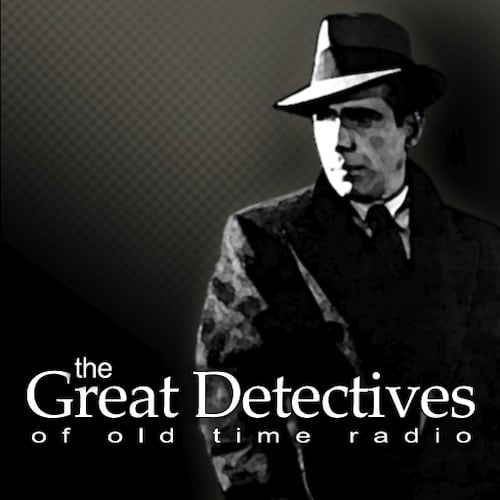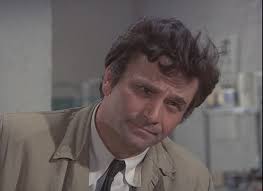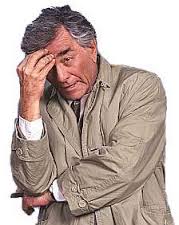I’ve experienced a lot of mysteries. I’ve listened to thousands of mystery plays and watched hundreds of hours of mystery TV shows and movies, and read a lot of mystery novels and short stories. With all those mysteries under my belt, I’ve noticed some popular tropes or plot points that often are silly and don’t make sense. Most of these can be used effectively if done right, but they so rarely are.
4) The Dying Clue
You’ve been shot, poisoned, or knifed. You have seconds to live and you know who your murderer is and want to reveal who murdered you, so you leave a dying clue.
Dying clues get silly when they get complicated. The dying person may have 20-30 seconds to leave a clue. They don’t have time to develop a complex cipher based on objects on their desk or develop codes. Sometimes the writer knows they’re being absurd and will write an excuse for their overly complicated last clues. “She loved puzzles,” they write as an explanation for why the victim left behind a clue requiring knowledge of proper verb tenses in Swahili and popular Elizabethan riddles. (I exaggerate slightly.) These seem to be ways writers show their cleverness but I have yet to see a dying clue that was more clever than it was ridiculous.
Better Ways to Do It:
Keeping the dying clue simple is a good idea in theory but if it’s too simple, you don’t have much of a mystery. I like the idea of an unfinished dying clue that’s puzzling because the victim couldn’t finish it before expiring.
Another great idea is to make the dying clue a distraction. For example, sometimes the killer will fake a dying clue to implicate someone else. Or it might be possible the victim thinks they know who the killer is but don’t, or imagine someone who hates another person so much they would rather that person suffer than their actual murderer be found.
3) Witness Getting Killed Before They Can Talk to the Detective
The detective takes a phone call from a witness.
The witness cries out. “I know who did it and I’ll tell you everything.”
“Who was it?”
“Not over the phone. Meet me in an hour at the old, poorly lit warehouse with no street lights where the killer could come up from behind me, murder me, get my body out of sight, and get away with no possibility of any direct witnesses.”
The detective says, “See you then,” before hanging up the phone.
Of course, the detective finds the witness murdered but maybe a clue that will point him towards the culprit.
This should not be confused with the witness about to reveal everything right away and then they’re shot. That builds suspense. It annoys the audience but the writer has to have their fun.
The problem with the, “Meet me and I’ll tell you who did it.” trope is it makes the detective into something of a sap. I used this once in my novel Slime Incorporated, but this was my hero’s first murder mystery. However, I’ve read characters who have appeared across multiple novels and/or TV episodes who have lost a witness that way before and agree to it anyway without batting an eye, which makes them thick and foolish. Plus everyone expects it’s coming.
Better Ways to Do It:
The detective should have enough sense to try and dissuade their witness from making such an obvious mistake. Maybe they try to get them to stay where they’re at or to meet them near a public place or to tell them over the phone. If the writer needs to kill off the witness, it can be despite the detective’s best efforts, not because the detective didn’t remember the last time a witness was gunned down in a hail of bullets.
Also, misdirection can work here. One of my favorite alternatives is to have the witness survive and turn out to be the murderer deflecting suspicion by looking like a potential target.
2) Rube Goldberg Murder Methods
Murders are generally performed through a variety of very basic methods. However, for a certain type of writer, it’s often occurred to make murder methods as complex as possible, involving elaborate and impractical mechanisms. Many of these elaborate approaches are so complicated a minor mistake can foil them or can kill someone else, leaving the intended victim alive. While I think Raymond Chandler’s critique of some puzzle mystery was a bit broad in his famous essay “The Simple Art of Murder,” he does hit the nail on the head when it comes to such overly complex schemes:
they do not really come off intellectually as problems, and they do not come off artistically as fiction. They are too contrived, and too little aware of what goes on in the world. They try to be honest, but honesty is an art. The poor writer is dishonest without knowing it, and the fairly good one can be dishonest because he doesn’t know what to be honest about. He thinks a complicated murder scheme which baffles the lazy reader, who won’t be bothered itemizing the details, will also baffle the police, whose business is with details. The boys with their feet on the desks know that the easiest murder case in the world to break is the one somebody tried to get very cute with; the one that really bothers them is the e murder somebody only thought of two minutes before he pulled it off.
Better Ways to Do It:
There has to be a good, believable reason for why the murder was complex. There should be a reason why the murderer chose an elaborate plot involving the shipping of Russian dolls, a hijacking, sabotaging a Toyota dealership, and the end result being a poisoned postcard sent to the intended victim when they could have just shot them. The TV series Monk usually did a good job justifying its outlandish and complicated plots. The episode Mr. Monk and the Sleeping Suspect is a great example.
Sometimes a character can justify the elaborate murder plot. Many episodes of Columbo featured plots that were elaborate and impractical. However, the series got away with it because the over-the-top methods spoke to an overly confident, arrogant killer who believed he was smarter than anyone.
1) Night Club Photographers Must Die
In these stories, the detective discovers someone was murdered to suppress a picture taken by a night club photographer or the like. Why? To hide someone who was in the background (such as a mob boss.) This was done way too much in older TV, movies, and radio programs.
The criminal is scared of the photo being found and implicating them in a crime. So to avoid being recognized in a random photo, they leave a string of bodies about that will draw the entire police force onto their trail, as well as any heroic private operatives. It’s the silliest idea any criminal could have. In reality, 999 times out of 1000, the nightclub photo will get shoved in a purse or box for decades and looked at rarely. Any of us could have organized crime figures waltzing around in the background of pictures we had randomly taken and we’d be none the wiser.
This applies to vintage mysteries. In the modern era, many individuals (whether employed by law enforcement or freelancing) do a search through photos posted online in hopes of finding clues to crimes. So criminals would have a motive to stop someone who got them in the background, but it’s difficult to suppress digital photos. A desperate criminal might kill a photographer, grab their phone, and run over it with a car within a minute of the photo being taken and still have the incriminating photos already uploaded to the Internet, where they will garner attention from law enforcement all the more after the murder.
Whether it’s the 1940s or the 2020s, it doesn’t make sense for a criminal to kill someone for taking a random photo of them, although for slightly different reasons.
Better Ways to Do It
In stories set in the past, there are many plausible fixes. For example, the photographer might be a crime buff, realize what they have, and blackmail the criminal. Or the nightclub photographer might be a disgraced photojournalist who recognizes the person in the background. And if you substitute a news photographer for a nightclub photographer, this becomes real because a photo with the suspect in the background could be seen by millions of people.
It could also work if the writer gives them a reason for it, such as an extreme phobia or psychological compulsion. Or if the decision is being governed by someone who’s got ulterior motives.
It’s harder to make it work in a modern-day setting. Every idea that came to my mind was still half-baked. My wife’s best suggestion is a revenge killing over a nude photo posted as revenge by an angry ex, which either ditches any criminals being in the background or renders this plot point only a red herring.
What are your thoughts on the silliest mystery tropes? Do you agree? Disagree? Have you seen examples of these tropes done well? Do you have other tropes you think belong in the list. Write about it in the comments.


